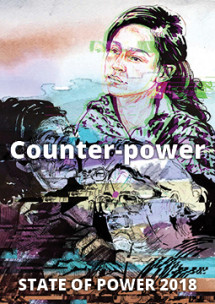Counter-power State of Power 2018
Topics
Popular movements everywhere are on the rise at the same time as we face ever-greater corporate impunity and increasing state violence. In TNI's seventh flagship State of Power report, we examine today's social movements, their potential to build counter-power, and how we can best resist injustice as well as lay grounds for long-term transformation.

Downloads
Marching forward: Women, resistance and counter-power
An interview with Bertha Zúñiga Cáceres, Medha Patkar and Nonhle Mbuthuma
As hundreds of thousands of women prepare to join more than 250 marches across the US and the world, three inspiring social movement leaders from Honduras, India and South Africa share their perspectives on how to build durable and effective popular movements.
Special website '50 years of counter-power' featuring 50 powerful stories of people-led resistance and transformation between 1968 and 2018 that have shaped our world.
Essays'Beneath the pavements, the beach' - or the whirlpool? Lessons of 1968
Hilary Wainwright
The revolutions of 1968 have an ambivalent legacy - they both regenerated capitalism but also experimented with forms of participation and transformative power that can and are inspiring today's social movements.
> Read online
Thinking Freedom: achieving the impossible collectively
Interview with Michael Neocosmos
Real emancipation emerges out of the universalist thinking that emerges from collective struggle and must not be conflated with the politics of representation whether by parties or states.
> Read online
From protest movements to transformative politics
Luciana Castellina
Movements are not enough to build counter-power. There is a need for a new kind of political party to mediate organized and diverse peoples and to rebuild the connective tissue that binds society and politics.
> Read online
Without translation, no hay revolución!
Alice Froidevaux and Eline Müller
Language – and thus translation and interpretation – is about access, about participation, about power. How can we bring about language justice within transnational social movements?
> Read online
Building feminist counter-power: In for the long haul
Nina Power
There is a new feminist militancy on the streets, across the globe and in the air. Social movements should use this moment to overcome the socialization of girls and boys that has been so hard to shift in order to permanently end the bullying and harassment typified in the likes of Trump.
> Read online
Flowing Movement: Building alternative water governance in Mexico
Gerardo Alatorre Frenk
The Mexican government's decision to acknowledge access to water as a human right led to a massive civil society response including 99 public forums to define what good water governance looks like. What can we learn from the experience?
> Read online
Making counter-power out of madness
Laura Flanders
How can movements in the US build counter-power out of Trumpian madness? Against the odds, a new vision is emerging that seeks to bring together a systemic critique with an embodied practice based on shared decision-making, solidarity economics and community-based approaches to prosperity and security.
>Read online
Madrid's Community Gardens: Where neighbourhood counter-power puts down roots
José Luis Fernández Casadevante Kois, Nerea Morán and Nuria del Viso
What if, rather than the barricade, we were to think of counter-power in terms of a space such as a community garden?
> Read online
People in defence of life and territory: Counter-power and self-defence in Latin America
Raúl Zibechi
Against a backdrop of state and corporate violence that threatens the lives of the poorest, many communities in Latin America have created self-defence groups and community police forces. How do these counter-power structures differ from those of the state?
> Read online
Fighting for public health: How a Swedish rural community confronted neoliberal cutbacks
Desirée Enlund
The rural communities in the Västernorrland county of Northern Sweden are not used to being in the national spotlight, but in 2017 their struggle to stop cutbacks in maternity and emergency care made national news. What lessons can we learn on how to build counter-power in rural areas of the Global North?
Examining Barcelona en Comú's attempt to be a movement party
Andreea Zelinka
How successful has Barcelona en Comú been in democratizing the relationship between civil society and city institutions? Zelinka examines the dynamics and challenges through the neighbourhood assembly of Ciutat Vella.>
Drawing counter-power
Acclaimed Egyptian artist, Ammar Abo Bakr provided the illustrations for the essays supported by the graphic designer Adam Shalaan. The web design was by Evan Clayburg. Here Ammar reflects on the process and the importance of the 'glitches' in the illustrations.
> Read online
Did you enjoy this content? Then please consider supporting TNI.
Support our crucial research and help us to work on the critical issues of our time. We work at the crossroads of movements, activists, policy makers and scholars to enhance public debate and turn ideas into movement. Become a supporter now.

